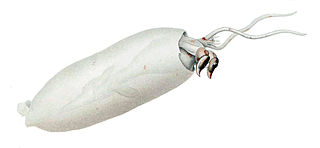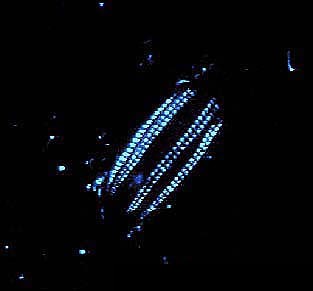
In zoology, a tentacle is a flexible, mobile, and elongated organ present in some species of animals, most of them invertebrates. In animal anatomy, tentacles usually occur in one or more pairs. Anatomically, the tentacles of animals work mainly like muscular hydrostats. Most forms of tentacles are used for grasping and feeding. Many are sensory organs, variously receptive to touch, vision, or to the smell or taste of particular foods or threats. Examples of such tentacles are the eyestalks of various kinds of snails. Some kinds of tentacles have both sensory and manipulatory functions.

Histioteuthidae is a family of Oegopsid squid. The family was previously considered to be monotypic but the World Register of Marine Species assigns two genera to this family.

Taoniinae is a subfamily containing ten genera of glass squids.

Odontochelys semitestacea is a Late Triassic relative of turtles. Before Pappochelys was discovered and Eunotosaurus was redescribed, Odontochelys was considered the oldest undisputed member of Pantestudines. It is the only known species in the genus Odontochelys and the family Odontochelyidae.

Helveticosaurus is an extinct genus of diapsid marine reptile known from the Middle Triassic of southern Switzerland. It contains a single species, Helveticosaurus zollingeri, known from the nearly complete holotype T 4352 collected at Cava Tre Fontane of Monte San Giorgio, an area well known for its rich record of marine life during the Middle Triassic.

Cydippida is an order of comb jellies. They are distinguished from other comb jellies by their spherical or oval bodies, and the fact their tentacles are branched, and can be retracted into pouches on either side of the pharynx. The order is not monophyletic, that is, more than one common ancestor is believed to exist.

Sinosaurosphargis is an extinct genus of basal marine saurosphargid reptile known from the Middle Triassic Guanling Formation of Yunnan and Guizhou Provinces, southwestern China. It contains a single species, Sinosaurosphargis yunguiensis.
Diandongosaurus is an extinct genus of eosauropterygian known from the lower Middle Triassic of Yunnan Province, southwestern China. It is known from the holotype IVPP V 17761, a complete and articulated skeleton with skull, which was found in the middle Triassic Lagerstätte of the Guanling Formation. It was first named by Qing-Hua Shang, Xiao-Chun Wu, Cun Li in 2011 and the type species is Diandongosaurus acutidentatus. A referred specimen suggests a total body length of 34 cm (13 in).

Prayidae is a family of marine invertebrates in the order Siphonophorae. They are colonial, and the colonies can superficially resemble jellyfish; although they appear to be a single organism, each specimen is actually a colony of Siphonophora.

Diandongosuchus is an extinct genus of archosauriform reptile, possibly a member of the Phytosauria, known from the Middle Triassic of China. The type species Diandongosuchus fuyuanensis was named in 2012 from the Zhuganpo Formation of Yunnan Province. It is a marine species that shows similarities with another Chinese Triassic species called Qianosuchus mixtus, although it has fewer adaptations toward marine life. It was originally classified as the basal-most member of the pseudosuchian clade Poposauroidea. However, a subsequent study conducted by Stocker et al. indicated it to be the basalmost known phytosaur instead.
Cephalopyge trematoides is a pelagic species of nudibranch. A free-swimming marine gastropod in the family Phylliroidae. Cephalopyge trematoides is the only known species in its genus.

Saurosphargidae is an extinct family of marine reptiles known from the early Middle Triassic of Europe and China.
Saurosphargis is an extinct genus of a basal marine reptile, saurosphargid, known from the Middle Triassic of southwestern Poland and eastern Netherlands. It contains a single species, Saurosphargis volzi.

Eusaurosphargis is an extinct genus of a diapsid reptile, known from the Middle Triassic Besano Formation of northern Italy and Prosanto Formation of south-eastern Switzerland. It contains a single species, Eusaurosphargis dalsassoi. It was a small reptile, measuring 20 cm (7.9 in) long.

Helveticosauridae is an extinct family of basal marine reptiles known from the Middle Triassic of southern Switzerland and northern Italy.

Euplokamis is a genus of ctenophores, or comb jellies, belonging to the monotypic family Euplokamididae. Despite living for hundreds of millions of years in marine environments, there is minimal research regarding Euplokamis, primarily due to their body structure. Research on the evolution of the basic body structures of diploblastic metazoans revealed that there are four major phyla, including the Ctenophores. Although the morphology of Euplokamis often resembles the medusa stage of Cnidarians, their eight rows of combs are one distinguishing feature that led to the official classification of Ctenophores. After being originally described by Chun (1879), the family Euplokamididae was expanded by Mills (1987) due to the discovery of a new species, Euplokamis dunlapae. Further research indicated that Euplokamis should be identified from Mertensiidae due to the rows of combs and some compression. They may also be distinguished from the genus Pleurobrachia due to their more elongated shape. Additionally, various adaptations of Euplokamis have been observed such as the use of tentacles for movement/feeding, a complex nervous system, and bioluminescent capabilities. Other characteristics including a defined mesoderm, lack of stinging cells, developmental differences, and symmetry supported the reclassification of these organisms.
Brevicaudosaurus is an extinct genus of nothosauroid marine sauropterygian from the Middle Triassic of China. The type species is B. jiyangshanensis and the holotype, IVPP V 18625, was prepared by Y.-F. Chen.
Euplokamis helicoides is a species of marine ctenophore. It has been reported to be a fast swimmer.
Euplokamis evansae is a marine species of ctenophore.
Euplokamis crinita is a marine species of ctenophore. The tentacles of the species have been reported to be smaller. This resulted in the species being argued to be in the genus Pleurobrachia, however according to WORMS, it stays in Euplokamis.











